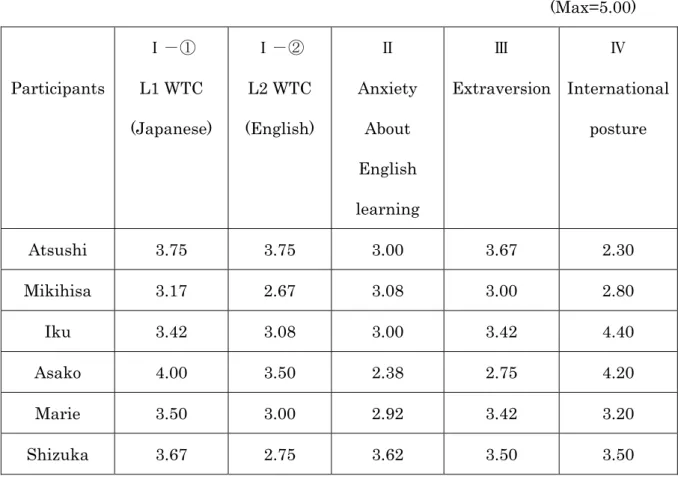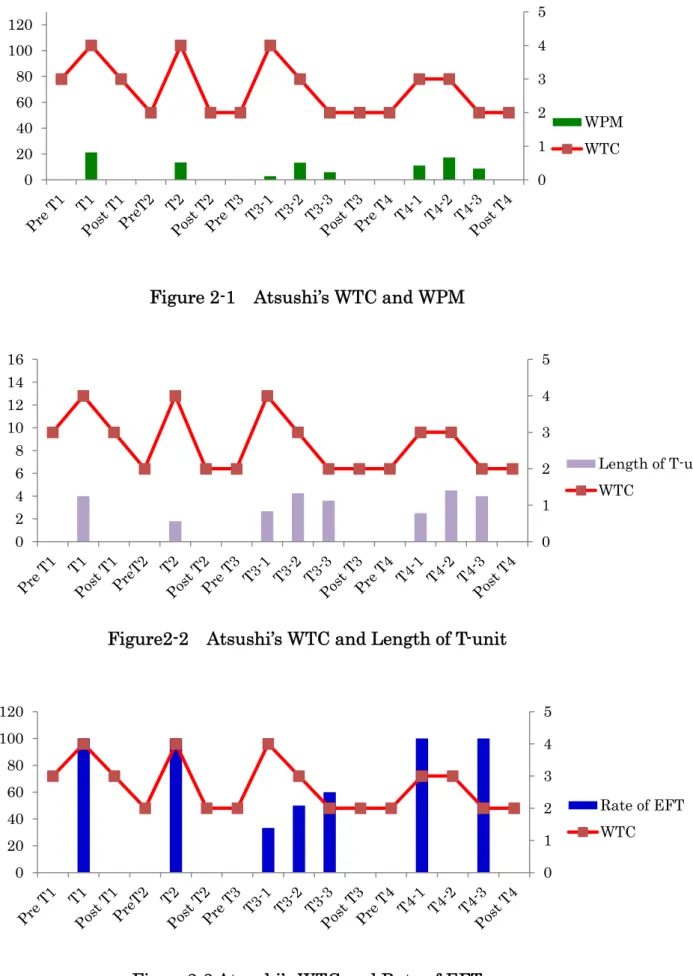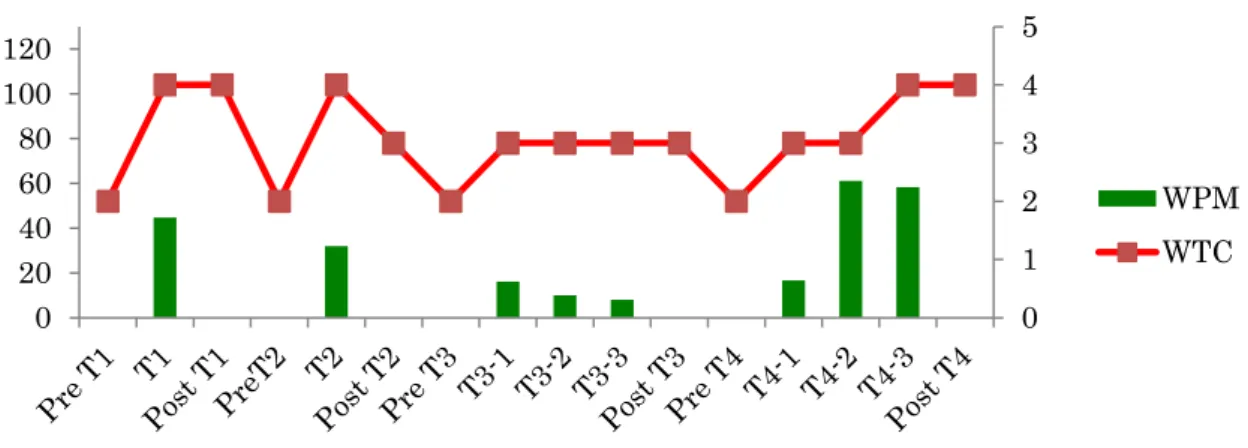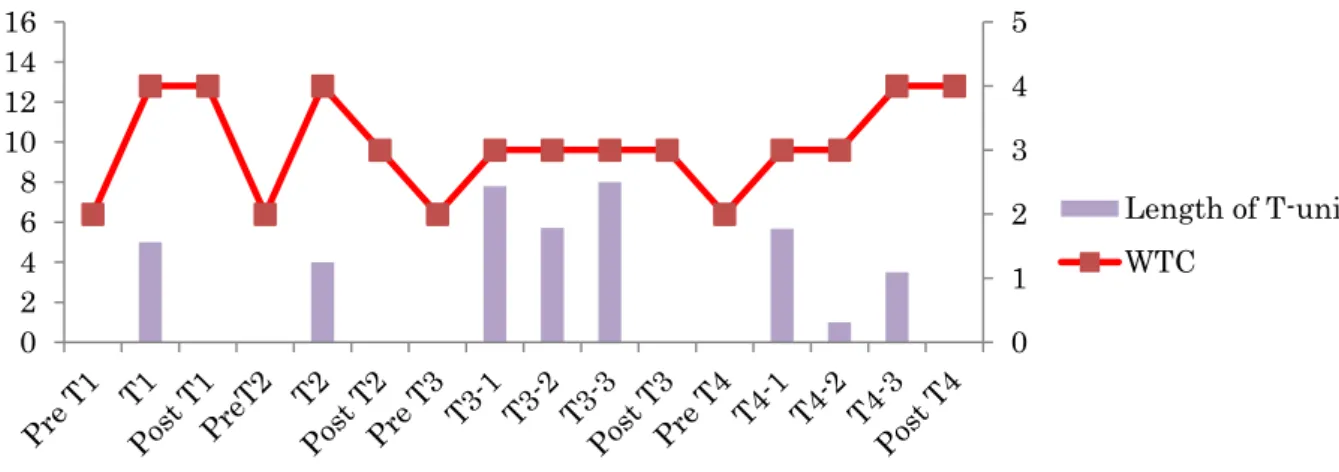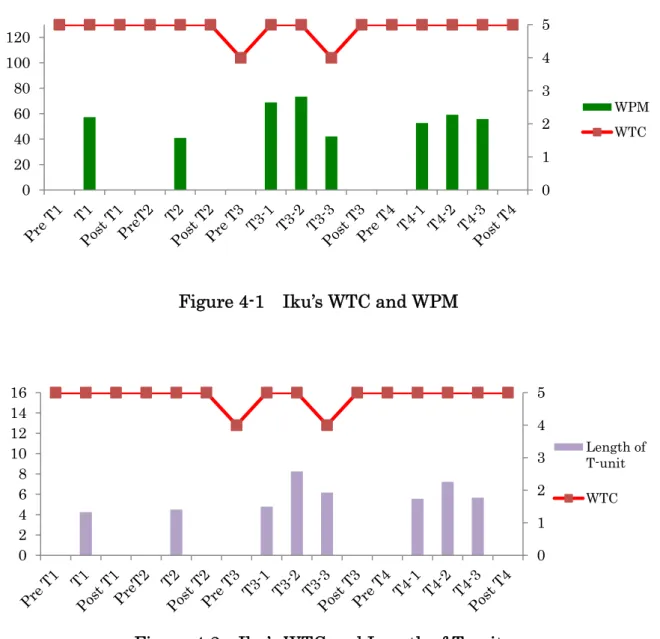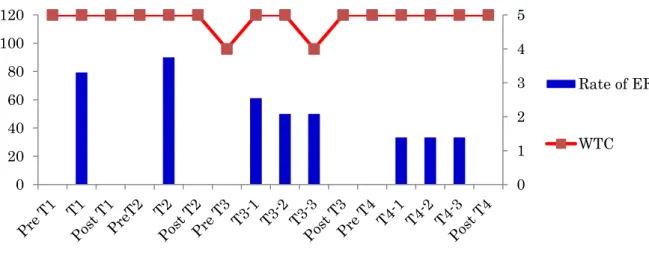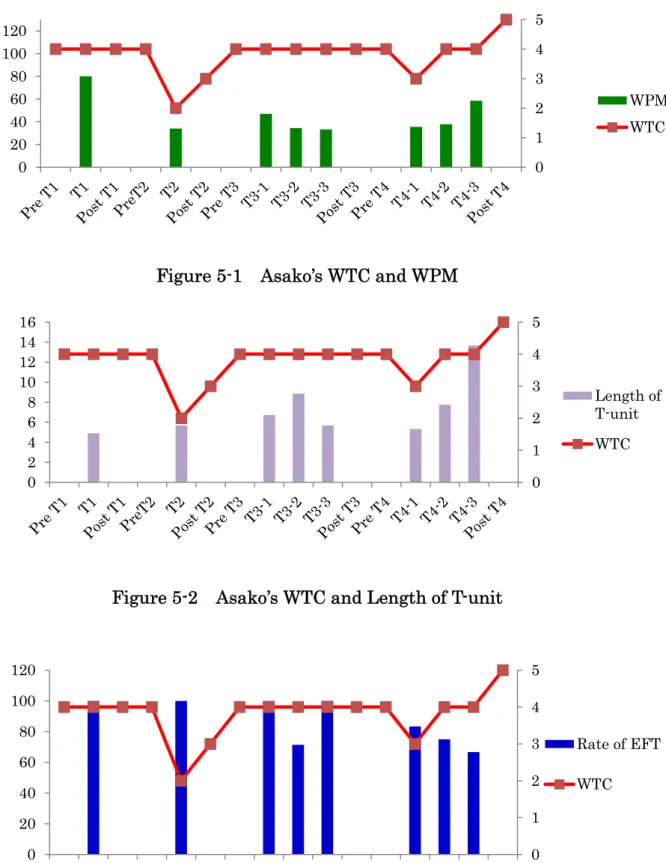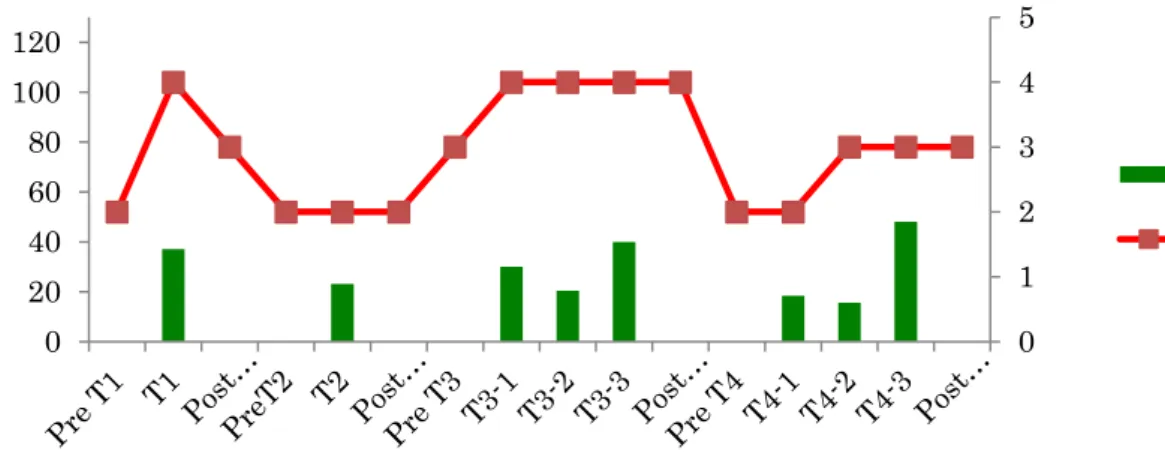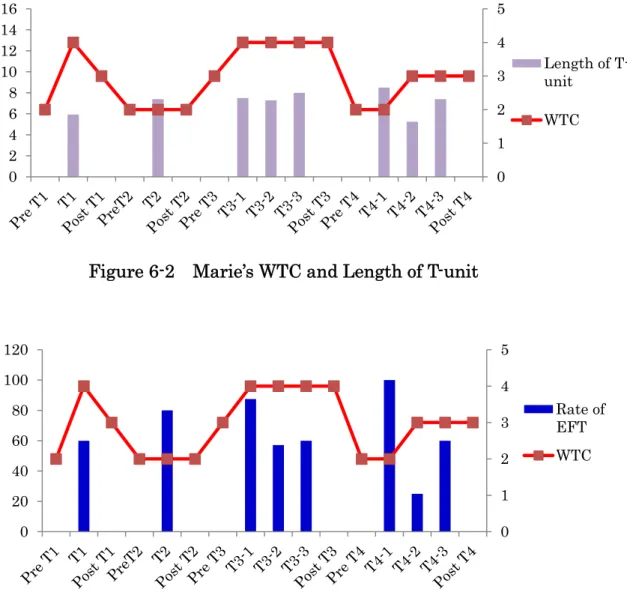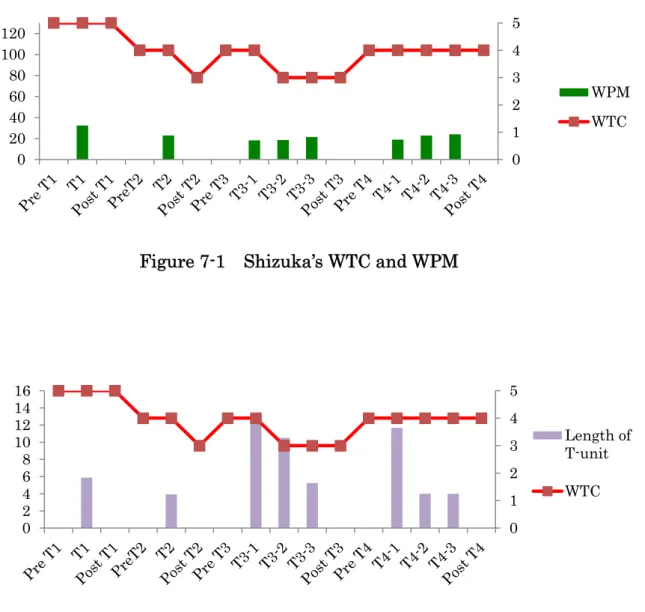H24年度修士論文
The Relationship between Task Performance and Changes in WTC of Japanese EFL Learners
日本人英語学習者に見られるタスクの達成度とWTCの変動の関係
A Thesis Presented to
The Department of Education Graduated School of Education
Hirosaki University
In partial Fulfillment of The Requirements for the Degree of
Master of Education
by
Ai Shimoyama
January 2013
弘前大学大学院教育学研究科 教科教育専攻英語科教育専修 下山 愛
平成25年1月
CONTENTS
ABSTRACT ・・・・・・・・・・・・・・・・・・・・・・・・・・・・・・・・1
CHAPTER 1 INTRODUCTION・・・・・・・・・・・・・・・・・・・・・・・2
CHAPTER 2 BACKGROUND・・・・・・・・・・・・・・・・・・・・・・・・6
2.1 WTC and L2WTC model ・・・・・・・・・・・・・・・・・・・・・・・・6 2.2 The contents of previous studies of foreign language context・・・・・・・・8 2.3 The study of WTC fluctuation・・・・・・・・・・・・・・・・・・・・・11
CHAPTER 3 PURPOSE・・・・・・・・・・・・・・・・・・・・・・・・・・15
CHAPTER 4 METHOD・・・・・・・・・・・・・・・・・・・・・・・・・・17
4.1 Participants・・・・・・・・・・・・・・・・・・・・・・・・・・・・・17
4.2 Materials・・・・・・・・・・・・・・・・・・・・・・・・・・・・・・19
4.3 Procedure・・・・・・・・・・・・・・・・・・・・・・・・・・・・・・21
CHAPTER 5 RESULTS AND DISCUSSION・・・・・・・・・・・・・・・・24 5.1 Analysis of the characteristics of the participants・・・・・・・・・・・・・24 5.2 Analysis of the task performance and WTC of individual participants・・・・27 5.2.1 The case of Atsushi・・・・・・・・・・・・・・・・・・・・・・・・・27 5.2.2 The case of Mikihisa・・・・・・・・・・・・・・・・・・・・・・・・32 5.2.3 The case of Iku・・・・・・・・・・・・・・・・・・・・・・・・・・・36 5.2.4 The case of Asako ・・・・・・・・・・・・・・・・・・・・・・・・・40 5.2.5 The case of Marie・・・・・・・・・・・・・・・・・・・・・・・・・43 5.2.6 The case of Shizuka・・・・・・・・・・・・・・・・・・・・・・・・46 5.3 Analysis of the factors and relationship between task performance and changes
in WTC・・・・・・・・・・・・・・・・・・・・・・・・・・・・・・・・49
5.3.1 Horizontal analysis of the participants’ fluctuation of WTC・・・・・・・49 5.3.2 Horizontal analysis of the participants’ performance・・・・・・・・・・50 5.3.3 Horizontal analysis of the relationship between the task recognition, task performance and WTC fluctuation・・・・・・・・・・・・・・・・・50 5.4 Pedagogical implications・・・・・・・・・・・・・・・・・・・・・・・・51
CHAPTER 6 CONCLUSION・・・・・・・・・・・・・・・・・・・・・・・・53
REFERENCES・・・・・・・・・・・・・・・・・・・・・・・・・・・・・・55
APPENDIX 1・・・・・・・・・・・・・・・・・・・・・・・・・・・・・・・57
APPENDIX 2・・・・・・・・・・・・・・・・・・・・・・・・・・・・・・・59
APPENDIX 3・・・・・・・・・・・・・・・・・・・・・・・・・・・・・・・67
ABSTRACT
Willingness to Communicate (WTC) is a key concept to account for first and second language communication. This study examined the actual conditions of WTC fluctuation in the real communication scenes with Japanese learners of English as a foreign language (EFL). A questionnaire survey and four EFL speaking tasks were conducted with six Japanese college students. Their speech scenes were video-recorded and were transcribed for analysis of the performance as well as for reference data for reflective semi-structured interviews which were conducted in Japanese with each participant after the tasks to consider the causes of his or her WTC fluctuation. The results revealed that the participants’ performance and their WTC influence each other interactively, causing WTC fluctuation. As learner variables directly influencing it, anxiety, impatience, and lack of confidence in using English were identified. The participants’ speech performance turned out to be in correlation with their WTC, which was closely related with the use of gestures and communication strategies as well. Learners’ recognition of task difficulty was found to be another significant predictor of their WTC, with vocabulary and grammatical knowledge being the most problematic issue. Their self-evaluation also played an important role in their WTC fluctuation, while task familiarity and communication experiences also played a part in it through actual language use. Pedagogical implications abstracted from the research results are discussed for their practical application in EFL classrooms.
CHAPTER 1 INTRODUCTION
Second language acquisition (SLA) is a complicated phenomenon which relates to various factors: learning environment, learning method, learning material that individual learners have, society where the target language is used, cultural background of that language, etc. Supposing there are some students who study the same language. But even if they can study in the same conditions and techniques, there may be a big difference between the results of their acquisition. Why does such a difference arise? And what kind of mechanism exists there? When we consider these questions, “leaner factors” emerge as the key concept.
It is believed that every learner has his or her own “learner factors” inherently and it affects his or her language learning or acquisition strongly. Learner factors consist of many elements such as age, gender, learning style, aptitude, motivation, learning strategy, and metacognition (Kojima, Hiromori, and Ozeki, 2010, p. 4). The first four factors can be grouped as “stable factors” because these are considered to be unchangeable as individual characteristics, while the last four factors can be grouped as “variable factor” that can change by educational intervention such as training and instruction.
From the viewpoints of communication, which is the final end of language acquisition, it is thought that the influence of affective factors, among others is very important for language learning and use. Above all, motivation, one of the major factors of the affective variables has been the principle theme of the academic research of SLA for a long time. And a lot of large-scale research focusing on this factor has been done in a multi-ethnic nation Canada.
Incipient research projects on the motivation factors were conducted by
Gardner and Lambert, the pioneers of affective variable research in SLA, with the social psychological approach. As the research progressed, the approach of educational psychology appeared to capture motivation more widely from the educational point of view. Two approaches were mixed gradually and were used in various SLA research projects for the motivational theories to be developed and deepened. However there were some problems in applying these motivation theories to all kinds of language learning environment. The bulk of the earlier research was conducted in the second language context, where the target language is used in learner’s daily life as well as in the classroom. It differs in many ways from the foreign language context, where the target languages used mostly in the classroom only. Thus, the research has conducted in the two different learning contexts have produced mixed results.
As the motivational factor were more thoroughly investigated in both language learning context, the concept of Willingness to Communicate (WTC) was introduced into the SLA research field from first language (L1) communication studies to encompass learners’ more fundamental communicative attitudes in second language (L2).
The final key to decide whether or not to communicate in certain situation is each person’s intention. WTC refers to such an intention to communicate spontaneously, and it is considered as one of the factors which support L2 use directly. As mentioned above, the concept of WTC was originally developed in L1 communication research by McCroskey (1992). Later, it was applied to L2 communication by L2 researchers (e.g., MacIntyre & Charos, 1996). Research into WTC in Second language (L2 WTC) explains that this concept is also appropriate in L2 or foreign language communication (Yashima, 2002). The “L2 WTC model,”
which MacIntyre et al. (1998) presented, shows many factors are related to L2 communication, and various kinds of research into the relationship among those factors have been advanced (see Fig.1 in Chapter 2).
It is thought that L2 WTC will be a useful conceptual device to a capture factors related to L2 use. The concept is expected to help to clarify the relationship among affective factors dealt with in the previous research more comprehensively. However, many of the previous studies were conducted in the second language learning or target language use environment. That is, the results shown by the previous studies cannot be directly applied to teaching and learning of English in Japan where the target language, i.e., English, is not a second language. As with other L2 factors research into WTC needs to take into account the target language environment in order to be fully understood. WTC research for Japanese learners of English as a foreign language (EFL) is still small number. By advancing further research for the Japanese EFL learners more detailed and concrete explanations of the relationship among affective factors, including WTC, will become possible. Such research will be likely to bring new insight into SLA research.
WTC in the previous research has been regarded as a rather lasting trait of L2 learners. For example, it is believed that the person with high WTC takes part in the classroom activity and communication positively than the person with low WTC.
However, a learner’s emotion in real communication situation is influenced by various factors on that occasion. And it should be changing continuously. I think it’s very important to explore the concrete fluctuation of WTC on that occasion to pursue the motivation research more deeply. But such research has not quite been done thus far.
The research which I refer to in the present study conceptualize WTC as a
factor which changes moment to moment on the real communication scene (MacIntyre & Legatto, 2011). It investigates the actual fluctuation of WTC depending on L2 speaking tasks. I will try to find concrete relationships between learners’ affective variables and their language performances in a similar method.
How does the WTC of Japanese EFL learners’ fluctuate? And what kinds of factors influence it? Are there any characteristic features or tendency? If I have some answers to such questions, even a little, it may contribute to the achievement of the goals of English education in our country. Pedagogical implications abstracted from the research results are discussed in the last part of this article for their classroom application in EFL classrooms.
CHAPTER 2 BACKGROUND
2.1 L1 WTC and L2 WTC
In this chapter, I discuss the concept of WTC and outline the previous studies on it. The beginning WTC research started to explore the reason why people are different in their attitudes toward communicative practice in the L1 context.
Definition of WTC in the first language (L1 WTC) offered by McCroskey (1992).
McCroskey defined WTC in a first language (L1 WTC) is the probability of initiating communication, specifically talking, when the opportunity arises (see MacIntyre et al. 1998). McCroskey showed that students with higher WTC were more positive in their L1 use in class and that WTC predicted actual communication acts as a result of classroom observation and questionnaire survey in L1 research. Moreover, Chan and McCroskey (1987) identified “communication anxiety” and “perceived communicative competence” as directly predictive factors of WTC.
Research into WTC in a second language (L2 WTC) research was also started in order to explore the factors which contribute to the positive attitude of L2 learners in L2 communication. And in L2 WTC research, MacIntyre et al. (1998) developed a pyramid type model of L2 WTC, with which he explains that L2 communication is more complex than L1 (see Fig. 1 below).
This model consists of six layers. MacIntyre et al. (1998) has set “promotion of L2 communication” for the final goal of L2 study. For this reason, “L2 use” is located in Layer 1 of the model. This “L2 use” is not only speaking but also listening, writing and reading. WTC is located in Layer 2. This means that WTC supports L2 use directly. And communication is also affected by many factors on the specific communication scene. So, “Desire to communicate with a Specific Person” and
Figure 1. L2 WTC model (MacIntyre, Clément, Dörnyei, & Noels, 1998, p. 547)
“State of Communicative Self-Confidence” are arranged as situational factors in Layer 3. The factors from Layer 1 to Layer 3 are grouped as changeable ones, and those in Layer 4 and below are grouped as stable ones by contrast.
There are three factors in Layer 4 as a motivation tendency that each learner has. That is, they are “Interpersonal Motivation”, “Intergroup Motivation” and
“Self-confidence”. For example, motivation to communicate with other people in the business scene differs from simple communication between friends. “Interpersonal Motivation” means the type of motivation that individual learners have.
“Intergroup Motivation” is the type of motivation to communicate with people who come from a different society and culture. “Self-Confidence” is a stable factor which is not influenced by communication situations by specific communication scenes
unlike the kind of confidence located in Layer 3, because it is the confidence over L2 use itself which learners have. These kinds of motivation cannot necessarily unchangeable, but in light of actual communication scenes they are observed to be relatively stable compare to the other stable.
In Layer 5, factors that learners’ affective and cognitive orientations pertain to are located. “Intergroup Attitude” is an attitude to integrate to the target language group, or the resistance against it. “Social situation” is a factor which is affected by the place where communication occurs or whether the purpose of communication is public or private. “Communicative Competence” is learners’ linguistic knowledge and their capability to use it at the time of communications. Layer 6, which supports the five above-mentioned layers, includes social backgrounds surrounding learners and their traits. “Intergroup Climate” assumes that the national traits based on political or historical relations between different groups are believed to influence communication. “Personality” is a trait that each learner has by birth.
This can be said to be a rather unchangeable factor.
2.2 The previous studies of WTC in foreign language contexts
The research by MacIntyre et al. (1998) was conducted in the contexts of second language learning and not those of foreign language learning like English learning in Japan. Yashima considered this circumstance and started L2 WTC research for the Japanese EFL learners. MacIntyre et al. defined L2 WTC as “a readiness to enter into discourse at a particular time with a specific person or persons, using L2”
(p.547). Yashima (2004) used her own definition of L2 WTC: “the intention to communicate spontaneously” in her studies. For the operational definition of WTC in the present research, I combine both definitions and reformulate as the intention
to communicate with a specific person in a specific communication situation spontaneously, using English.
Some factors that seem to be specific to foreign language environments were clarified in the previous studies by Yashima (Yashima, 2002, 2004). “International posture” is one of the characteristic features of them. Yashima (2002) conducted a questionnaire survey with college students. In her model of WTC, it is hypothesized that “International posture” and “Confidence of L2 communication” influence WTC directly. “International posture” is a concept that Yashima (2002) proposes to describe learners’ overall orientation toward internationalism, such as interest in foreign language and cultures or longing to engage in international occupations.
English for Japanese college students seems to symbolize of international societies, and as a result, their intention to communicate in English become stronger when they have a clear purpose that concerns themselves with such global societies.
Moreover, “Confidence of L2 communication” is assumed to be influenced by two more factors which are “Communication anxiety” and “Perceived communicative competence”, both being important in L2 learning and use. These factors were addressed in the research by Yashima (2004) as well which focused on Japanese high school students’ WTC in learning English.
Yashima (2004) investigated the following two viewpoints: relationships of WTC and English communication frequency inside and outside of the classroom, and affective factors which influence WTC. The results show that students with high WTC have a high frequency in English use. Students with a high international posture have both high WTC and a high communication frequency. It turned out that WTC did influence communication activities inside and outside of the classroom.
Based on the above-mentioned previous research on WTC, the study which focused on Japanese public high school students was conducted by the present author (Shimoyama, 2012). The purpose of the research was to investigate the real conditions of the students’ willingness toward the present English classes and communication activities in Japan. This research addressed “Foreign language anxiety”, “International posture”, and “Intention to learn English” for searching the actual consciousness that the students have. Although this research was not designed to investigate L2 WTC directly, it was expected to help to clarify the real conditions of Japanese public high school students’ L2 WTC in learning English.
Previous L2 WTC research focused mainly on elementary school students, junior high school students, and college students. However, there is little research which focused on high school students. In addition, the participants in the research by Yashima (2004) were private high school students in specialized in studying English, so there are not so many studies for public high school students. Furthermore, the English teaching policy to conduct English lessons basically in English only was adopted in the 2010 revised Course of Study issued by the Japanese Ministry of Education, which leads to the following two questions to be answered: (1 what kinds of consciousness do ordinary high school students have to the present English classes?, and (2 how do they feel about communication-oriented English classes, or how willing are they to participate in those classes? In order to examine these questions, a questionnaire survey was conducted with public high school students.
The research found out that the students had a more desire for grammar-oriented lesson classes rather than communication-oriented ones. It was also shown that the students with a more desire for grammar-oriented classes tended to have lower anxiety and higher self-evaluation generally. In contrast, the
students with higher anxiety had both lower desire for the grammar-oriented classes and lower self-evaluation. Furthermore, an international posture and an integrative motivation seemed to tend to increase the students’ willingness to study English. The students with higher motivation seemed to tend to have a stronger desire for communication-oriented learning activities.
The research results obtained by Shimoyama (2012) are most noteworthy in that there was little relationship seen between anxiety and WTC, because the studies prior to this shows that low anxiety tended to higher WTC. On the other hand, the result about the international posture conformed to the previous works by Yashima (2004). Anxiety and self-evaluation were closely connected with grammar-oriented English classes. From these result, it is supposed that the students may have many opportunities to receive explicit evaluation in grammar-oriented classes, which will help to make the students’ anxiety higher and their self-evaluation lower. Probably, there may be a strong influence of the way of teaching English or educational style in Japan on the background of these examples.
To understand the details of the current English education in Japan is very useful, because communication-oriented activities in English classes will be more important than ever.
2.3 The study of WTC fluctuation
Moreover, a new type of L2 WTC research has been advanced in recent years.
MacIntyre and Legatto (2011) conceptualize WTC as a factor which changes moment to moment on the real communication scene. The research investigates the fluctuation of WTC using L2 speaking tasks and what is called the Idiodynamic Method. The Idiodynamic Method is based on the research of a
personality theory that Gordon Allport, an American psychologist, advocated (Allport, 1937). He considered that personality is composed of two types of traits:
“common characteristics” and “individual characteristics”. The former factor is supposed to be compared to the factors of other people, while the latter one cannot be compared to any other factors because it is unique to each individual person. He emphasized that human behavior can be predicted by learning these characteristics and examining them in learners’ real actions. His theory is different from the theory of general behaviorist psychology in that it lays more on characteristics than actions. These characteristics that bring about differences in action patterns of people are called “idiodynamics”.
On the other hand, Rosenzweig (1986) focused on the situations rather than the characteristics as a key to understanding personality. He examined the relationships among “common characteristics”, “individual characteristics”, and the specific situation in question, on the basis of the Allport theory (as cited in MacIntyre & Legato, 2011). It is expected that such theories can also be applied to L2 communication behavior. Although the common and individual characteristics of learners were considered in the WTC model, research which investigates the concrete influence of WTC in a communication scene on learners’ behaviors was not conducted.
However, communication is a fluid phenomenon by people. It is appropriate to think that WTC fluctuates according to each individual communication situations.
From such a viewpoint, the purpose of the MacIntyre and Legatto study (MacIntyre
& Legatto, 2011) is to clarify the actual fluctuation of WTC, which had not been verified before during L2 speaking tasks with a hypothesis generation technique.
Five female college students took part in this study. The participants were
asked to answer a questionnaire and accomplish eight L2 speaking tasks. The participants rated their WTC for each task. The performance and speaking contents of each participant were recorded by a video camera, and it was used for the discussion of the reasons why WTC fluctuated in interviews conducted in their first language after the tasks. Analysis was conducted by “Horizontal analysis”, which considered the WTC fluctuation and speaking time of all the participants, was pursued with content analysis of the L1 interviews.
The most influential factor of WTC fluctuation revealed in the horizontal analysis was vocabulary. Especially, every participant felt difficulty when suitable words to express what they wanted to did not come out immediately, or, when they could not remember some of the words they needed. Also, they lost their motivation for speaking, and their WTC was falling on these occasions.
However, even if the words they needed did not come out immediately, the participants could get back their motivation and recover their weakened WTC when they remembered words that replace them or when they used their vocabulary smoothly. When they were faced with the difficult task topics, like education or politics, they had trouble with their speaking because they did not know technical terms. In the vertical analysis, it turned out that the participants’ WTC tended to decline when they lost their confidence unexpectedly or they felt anxiety about the tasks.
The participants’ task performance was also related with their WTC fluctuation.
If the participants found the topic fairy easy to talk about, even when they were supposed to be difficult types of topics, they tended use a lot of gestures and occasionally they use difficult vocabulary. On the other hand, when they thought the topic was rather difficult they used simple sentences, and the length and
frequency of pauses and silence increased and their speaking speed were decreased with the WTC decreased. WTC is closely connected with language behavior.
From a viewpoint of L2 research, the MacIntyre and Legatto study (MacIntyre
& Legatto, 2011) is attractive enough in that tried to clarify the actual conditions and involvement of the affective factors, especially those in Layer 1 to Layer 3 in the L2 WTC model. But if the same type of research is to be conducted in other broader contexts, it is expected not only to store new data, but also to lead to various
empirical studies in the educational settings. So I think it is useful to follow the methodology taken by MacIntyre and Legatto in their study for the purpose of exploring L2 WTC in Japanese EFL learning context. For this reason, I am going to consider the relationship between the affective factors and learner language in terms of WTC fluctuations and task performance in English as a foreign language.
CHAPTER 3 PURPOSE
This chapter describes the purpose, goal, and research questions of the present study. The purpose is to investigate the actual conditions of WTC fluctuation in a real communication scene in English. How does WTC fluctuate when learners speak in English? What kinds of factors are there to cause the fluctuation? Are there any features or tendencies in their performance? By finding answers to these questions, the present study is expected to contribute to clarifying a higher rank of motivational system of L2 use. The research goal is to clarify the relationships among learners’ traits, performances, and WTC fluctuation. The following research questions (RQ) were addressed directly.
RQ 1: How does learners’ WTC fluctuate in performing speaking tasks?
RQ 2: What features or tendency can be seen in learners’ task performance?
RQ 3: How do learners’ recognize their WTC fluctuations and task performance?
RQ 1 is to directly examine “WTC” in Layer 2 in the WTC model. That is learners’ WTC fluctuation in performing speaking tasks will be described and analyzed. RQ 2 addresses learners’ task performance, which represents “L2 use” in Layer 1 in L2 WTC model, and identifies possible features and tendencies of the speech observed in the speaking tasks. The quality of the speech is going to be examined in terms of “fluency”, “accuracy” and “complexity”. RQ 3 focuses on the changeable factors in Layer 3. Here, learners’ own recognition of their WTC fluctuation and task performance will be considered. Interviews with learners are to be set up after the speaking tasks to consider their recognition. The factors which
are regarded as more or less unchangeable are listed in Layer 4 in the WTC model go into the consideration as well. The factors to be in cooperated into the analysis include “Japanese WTC (L1 WTC)”, “English WTC (L2 WTC)”, “Anxiety about English learning”, “Extroversion”, and “International posture”, all of which were specifically treated in the research by Shimoyama (2012).
CHAPTER 4 METHOD
4.1 Participants
Six Japanese college students took part in this study. All of them were freshmen, and they were chosen at random regardless of their gender, major, English proficiency, and English learning background in order to gather as many different learning viewpoints as possible. The following is the information of each participant. In considering their privacy, all the names are fictitious in this study.
Participant 1: Atsushi Sex: Male
Major: Economics and management TOEIC score: 350
English learning experience outside class: Nothing special.
Additional comment on English learning:
He thinks he is not good at English.
Participant 2: Mikihisa Sex: Male
Major: Mathematics TOEIC score: 495
English learning experience outside class: Nothing special.
Additional comment on English learning:
He thinks he is not good at English, especially listening, and is not confident in speaking.
Participant 3: Iku Sex: Female
Faculty: European and American cultures TOEIC score: 480
English learning experience outside class:
Nothing special, but she hopes to study abroad in the future.
Additional comment on English learning:
She loves to communicate with foreigners and enjoy it very much. She also brushes up her English skills eagerly in the ESS club.
Participant 4: Asako Sex: Female Major: Medicine TOEIC score: 630
English learning experience outside class:
She home-stayed in New Zealand for three weeks when she was in high school. She practices speaking English in a club activity at least four times per week. She also attends English speaking sessions offered by the English self-learning center.
Additional comment on English learning:
She has a dream to go overseas and work with foreigners using English.
Participant 5: Marie Sex: Female
Major: English Teaching
TOEIC score: Score unavailable.
English learning experience outside class: Nothing special.
Additional comment on English learning:
She feels she is not so good at speaking English but she likes it. She studies English hard on her own and also in the ESS club.
Participant 6: Shizuka Sex: Female
Major: Teaching of English TOEIC score: 420
English learning experience outside class:
She took English lessons from foreign lecturer at kindergarten. She home stayed in New Zealand for two weeks when she was in high school.
Additional comment on English learning:
She says that she cannot speak English well, but that she likes English. She says English is her only favorite subject, and she takes pride in keeping good grades. She studies English very hard.
4.2 Materials
Questionnaire
A questionnaire survey was conducted for the purpose of the investigating the participants’ traits. The questionnaire consists of 60 items in the following five categories. For measurement, a five-point Likert scale was adapted.
1. “Willingness to speak spontaneously in Japanese (L1 WTC)” (12 items of “L1
WTC”)
2. “Willingness to speak spontaneously in English (L2 WTC)” (12 items of “L2 WTC”)
3. “Anxiety about English learning in class” (13 items) 4. “Extroversion” (12 items)
5. “International posture” (10 items and one free description item)
Speaking tasks
The speaking tasks were conducted by an American interviewer. There are four tasks in total, and the time for performing them is expected to last for 30 minutes totally.
Task 1: Self-introduction (5 minutes).
Task 2: Description of the clothes that the participants wearing and the explanation of their favorite fashion styles (5 minutes).
Task 3: Making a story with four frame picture and explaining it (10 minutes).
Task 4: Free talking about the Japanese college education system (10 minutes).
The first two tasks were supposed to be easy ones, while latter two were intended to be rather difficult for the participants because of the possible unfamiliarity of the topics. The picture used in Task 3 is shown in APPENDIX 1.
WTC scale
The participants were asked to rate their own WTC on the evaluation sheets of WTC fluctuation (see APPENDIX 3). They also used a five-point Likert scale
ranging from 1 (very weak) to 5 (very strong).
Task 1 and Task 2 consist of three parts: pre-task, task part (indicated as T1 and T2 in the graphs below) and post-task. The length for Task 3 and Task 4 is longer than for Task 1 and Task 2, so they were divided into five parts: pre-task, the first part of the task (indicated as T3-1 and T4-1 in the graphs below), the second part of the task (indicated as T3-2 and T4-2 in the graphs below), the third part of the task (indicated as T3-3 and T4-3 in the graphs below) and post-task. The participants were asked to divide these parts by themselves since their task achievement time varied among the participants.
Content analysis was conducted with the interview data for each task and also each task stage that was determined by the researcher based on the turning points of the topics in the Japanese interview. Moreover, if there was a remarkable WTC fluctuation or if they noticed something while they were carrying out the tasks, they were asked to describe it in the evaluating sheet as well. The contents of these descriptions were used when needed.
4.3 Procedure
The procedure of this research is as follows.
1) Questionnaire: A questionnaire survey was given to each participant to investigate their traits.
2) Speaking tasks: The participants were asked to work on four speaking tasks with a native speaker of English (an American) being an interviewer.
3) Self-rating: The participants rated their WTC fluctuation watching the recorded video of their task performance.
4) Post-task interview: A semi-structured interview was conducted with each individual participant. In this interview, they were asked about their experiences during the tasks and the reason of their WTC fluctuation by checking the recoded video with the researcher.
The results of the questionnaire survey were used to consider the participants’
characteristics in the next chapter. In procedure 2 above, the researcher recorded the participants’ utterances during tasks with a video camera and an IC recorder.
The speaking contents of each participant were transcribed and analyzed in terms of the following viewpoints: total number of words uttered during the tasks (indicator of expressiveness), words per minute (WPM; indicator of fluency), T-unit (an independent clause plus a subordinate clause, if necessary, that can be an independent sentence; indicator of complexity), and error free T-unit (EFT; indicator of accuracy). The total number of words uttered in the tasks was explained when there is remarkable difference among the participants. Any utterance that lasted less than one minute was interpreted to lack expressiveness. WPM shows the amount of speaking for every one minute. It can be calculated by dividing the total words uttered during the tasks by the task performance time and converting the results in proportion to one minute. As for complexity, the total words uttered during the tasks were divided by the total T-units. EFT was shown in the percentage of how many error-free T-units are contained in all the T-units. WTC, which was measured in Procedure 3, was shown in the graphs and it was used for fluctuation consideration of each task in the following chapter 5.2.
The interview with the participants in Japanese in Procedure 4 above was recorded using the IC recorder. It was transcribed and used for the content analysis.
The content analysis is referred to the scene when it considered the participants’ recognition of task difficulty, the cause of WTC fluctuation in each task, and the quality of task performance with each participant. The participants’
gestures and speech patterns video-recorded during the tasks were also analyzed and discussed when necessary.
CHAPTER 5 RESULTS AND DISCUSSION
I discuss the results of the questionnaire in section 5.1 to describe the characteristics of each participant first. The descriptive data of individual participant are used to supplements the discussion of their WTC and task performance in the sections to follow. Then I consider the fluctuations of individual participant’s WTC in section 5.2, I also examine each individual case, using the graph of WTC fluctuation and the content analysis of the interviews conducted in Japanese (vertical analysis). Lastly, I make hypotheses about the fluctuations of WTC and its contributing factors by summarizing the vertical analysis made in the previous section. I highlight the particularly characteristic reactions observed in the participants and make generalizations out of them (horizontal analysis).
5.1 Analysis of the characteristics of the participants
Table 1 below summarizes the results of the questionnaire conducted before the task. The table describes the average points for each question category. On the whole, the participants’ L1 WTC is higher than L2 WTC apart from Atsushi. This is because they do not have less confidence to express their thoughts in English than in Japanese, since English is not used in their daily life. The participants’ anxiety about English learning is almost at a medium degree. Their international posture can be divided into three levels, according to their self-ratings. Atsushi is the second highest in L1 WTC, and his L2 WTC and extroversion ratings are the highest among the six participants. His anxiety is at the middle level and international posture the lowest of all. Mikihisa’s L1 WTC and L2 WTC are the lowest. His anxiety and extroversion show medium degrees. As for the international posture, he
Table 1
Average scores of each participant for the questionnaire categories
(Max=5.00)Participants
Ⅰ-① L1 WTC (Japanese)
Ⅰ-② L2 WTC (English)
Ⅱ Anxiety
About English learning
Ⅲ Extraversion
Ⅳ International
posture
Atsushi 3.75 3.75 3.00 3.67 2.30
Mikihisa 3.17 2.67 3.08 3.00 2.80
Iku 3.42 3.08 3.00 3.42 4.40 Asako 4.00 3.50 2.38 2.75 4.20 Marie 3.50 3.00 2.92 3.42 3.20 Shizuka 3.67 2.75 3.62 3.50 3.50
is higher than Atsushi, but he is the second lowest of all. Iku’s L1 WTC and extroversion are a little above the average. Her L2 WTC and anxiety are at the middle level, while her international posture shows the highest degree of all the participants. Asako is a person with the highest L1 WTC and L2 WTC and the second highest international posture. Also, her anxiety and extroversion are relatively low. Marie’s anxiety is the second lowest, and her L1 WTC and extroversion are a little above the average, while her L2 WTC and international posture are at the middle level. Shizuka is a person with the highest anxiety, and her other values are a little above the average. From the information above, each participant’s characters are described as follows.
Atsushi
Atsushi has a strong willingness to speak in both Japanese and English basically. This may be because of his high extroversion and low anxiety. However, he is not so interested in international matters using English. In this point, his does not seem to be a person who speaks English spontaneously out of his own will.
Mikihisa
Basically, Mikihisa seems to be a person who does not speaking English spontaneously. Moreover, from his low L2 WTC and international posture, it is expected that he will show a negative attitude toward speaking English.
Iku
Iku is a sociable person without hesitation to communicate with other people in general. Her international posture is the highest of all, so it is considered that she will show the most positive orientation for speaking English.
Asako
Apart from extroversion, Asako shows rather high points in all the items of the questionnaire survey. From this result, she seems to be a person who will not always speak spontaneously, but can speak easily when she has a necessity.
Marie
Basically, Marie has little resistance to speaking either in Japanese or in English. However, it seems that her spontaneity in speaking English is low.
Because her anxiety about learning English, L2 WTC and international posture are not so high.
Shizuka
Although she shows the highest anxiety about learning English, Shizuka seems to be willing to speak in English. This may be because her ratings in all the other items of the questionnaire are relatively high and contribute to it.
5.2 Analysis of the task performance and WTC of individual participants In this section, I conduct the vertical analysis by examining the participants’
WTC graphs which also describe their task performance and discussing how they recognize their own performance. In order to describe their task performance three different kinds of graphs are used: WTC and WPM (Fluency), WTC and the length of T-unit (Complexity), and WTC and the rate of EFT (Accuracy).
Fluency, complexity, and accuracy are shown by the bars with the left-side reference axis in the respective graphs. And WTC is represented by the red lines with the right-side reference axis. In addition to the participant’s speech data from the tasks, excerpts from the interviews in Japanese are used in order to investigate their recognition of the task performance. The questionnaire data are also used for the triangulation purpose.
5.2.1 The case of Atsushi
Figures 2-1 through 2-3 show Atsushi’s WTC and task performance graphs.
Atsushi’s WTC shows the biggest fluctuation among the six participants. His WTC line widely goes up and down in Task 1(T1) through Task 3(T3). If seeing more closely his WTC rises at the beginning of each task, and then it gradually declines as he progresses with the task.
Figure 2-1 Atsushi’s WTC and WPM
Figure2-2 Atsushi’s WTC and Length of T-unit
Figure2-3 Atsushi’s WTC and Rate of EFT
0 1 2 3 4 5
0 20 40 60 80 100 120
WPM WTC
0 1 2 3 4 5
0 2 4 6 8 10 12 14 16
Length of T-unit WTC
0 1 2 3 4 5
0 20 40 60 80 100 120
Rate of EFT WTC
5.2.1.1 Performance of Atsushi and his WTC fluctuation
Basically, Atsushi did not know how to express what he wanted to say in English, and he had a tendency to give up answering the questions, using phrases such as “I can't speak” or “Sorry”. He carried out his tasks in the form that he answers each question asked by the interviewer. Therefore, his WPM is low and there are some replies that took less than one minute (Task 2 and from the first part to the second part of Task 4). It should be noted that, in the part which lasts less than one minute, there is not so many utterances as the WPM graph shows.
Most of his speech was formed of easy sentences with two to four words, and the accuracy was reflected in the graph as almost perfect speaking (Task 1, Task 2, and the first and second parts of Task 4). A lot of pauses, silence, and repetitions of the same words appeared throughout his speaking. Therefore the speed of his speaking was very slow, and his fluency fell accordingly. In Task 3, his WPM is especially low and his speech lacks accuracy as well. It can be said that this is because he has to make longer and more difficult sentences than before, as the task becomes more difficult. Thus, he needs more time to think for reorganizing his thoughts with longer pauses. Also, he tries to use complicated sentences, but he noticed that he cannot do so, which results in an increase in imperfect sentences. Overall, it seems that there is a trade-off between complexity and accuracy; when the complexity falls, the accuracy rises. As for the relationship between his WTC fluctuation and task performance, his WTC fell after the rapid drop of fluency and accuracy.
5.2.1.2 Atsushi’s recognition of his task performance and his WTC fluctuation
Atsushi has a policy about speaking that it is not good to be silent and try to
answer question as much as possible. This policy raised his WTC and this is the strongest factor that influences his WTC as the following Japanese interview indicates.
I think it is bad to keep silent, so I try to answer questions. Therefore, my willingness to speak becomes high. (Task 1)
What affects my feelings is something that I can call my policy. It’s some kind of politeness to my partner in communication. In my case, it’s important to see the partner's eyes when I answer his or her questions and not to be silent. I think that the influence of that policy is the most influential factor to WTC.
He mentioned his negative self-evaluation that he could not answer well, as a factor which caused the decline of his WTC. In the third part of Task 4, he described that an accumulation of the negative self-evaluation through Task 1 to Task 3 lowered his WTC.
I know I couldn’t reply well in the first part of Task 3 either, and my motivation to answer questions went down little by little. I have a tendency to drag on my failures. I also couldn’t make responses enough in Task 1 to Task 3, so my ability to think became weaker than before. (The first part of Task 3 and all through Task 4)
Moreover, in the fall his WTC in Post-Task 1 to Pre-Task 2, he said that he felt anxiety like “What is the next question? I wondered whether I could I answer the question or not”. The anxiety led to a decline in his WTC here.
He felt difficulty in expressing what he wanted to say in English all through the tasks. He thought that this difficulty originated in his failure to recollect grammatical rules smoothly. However, his lack of knowledge of technical terms also prevented his speaking.
For me, even if the tasks were not so difficult, it was difficult to express my thoughts in English since suitable grammar or words did not come across my mind immediately.
I think Task 4 was difficult. Because I did not know enough technical terms or expressions about the college education, I was at a loss how to express my thoughts.
As for the reason his WTC started from the rating of 3 in Pre-Task 1, he said,
“Since I don't care about the language that I use, I was not nervous when I talked to the foreigner. I am not really good at speaking English, so I was not enthusiastic.
That's why I evaluated my rated WTC as 3.” From this statement, it can be assumed that his traits or personal characteristics, of which some were expected raise WTC and the others to lower it, counteracted one another and served to prevent his WTC from declining terribly. Moreover, his traits or characteristics also affected his negative evaluation of his task performance. He tries to be strict with himself and not to be lazy by nature. Regarding his rather severe self-evaluation, he gave a comment as below:
I was not able to express myself perfectly but I wanted to answer 70 to 80 % of the question in the tasks. When I watched the video after the tasks, I thought I knew those expressions, because they are in my head, like “Yes, it was this phrase”. So, I evaluated like this inevitably because I couldn’t say after all.
As seen from the interview excerpts above, he is faced with the dilemma of not being able to compose sentences in the actual communication scene which he should be able to do easily in the class room learning settings. Probably, this dilemma, together with his characteristic feature to give a harsh self-evaluation, became one of the causes for producing his WTC fluctuation.
5.2.2 The case of Mikihisa
Basically Mikihisa's WTC was low before the tasks began. During the tasks, it rose and maintained a certain level. But it declined before moving to the next task.
In Task 4, however, his WTC increased as the task continued to the end. WTC fluctuation as shown in Figures 3-1 through 3-3 below.
Figure 3-1 Mikihisa’s WTC and WPM
0 1 2 3 4 5
0 20 40 60 80 100 120
WPM WTC
Figure 3-2 Mikihisa’s WTC and Length of T-unit
Figure 3-3 Mikihisa’s WTC and Rate of EFT
5.2.2.1 Mikihisa's performance and WTC fluctuation
As for Mikihisa's speaking, it can be said that there was a trade-off relationship observed between accuracy and complexity. Again, it is necessary to note that his length of speech was less than one minute in Task 1, and Task 2 and from the second part to the third part of Task 4. Also, there was a phenomenon in which WTC went up with the rise of fluency. While he was speaking, he was seen to make a gesture of nodding several times immediately after his speech. Judging from the
0 1 2 3 4 5
0 2 4 6 8 10 12 14 16
Length of T-unit WTC
0 1 2 3 4 5
0 20 40 60 80 100 120
Rate of EFT WTC
outcome, this is probably because he was trying to confirm what he was saying point by point before moving the next speech. Because the nodding appears when his fluency was increased, and considering the relationship between WTC and fluency, it can be thought that the gesture itself played an auxiliary role to maintain or improve his WTC at that moment.
5.2.2.2 Mikihisa’s recognition of task, task performance and WTC fluctuation
Mikihisa stated that, during the task, he concentrated on his thinking so that WTC went up. He also said that the cause of WTC decline was his "negative self-evaluation", which was the result of having been unable to speak properly like Atsushi’s case discussed above. In Task 3, he mentioned that because he kept concentrating on his thinking and he also had the negative self-evaluation concurrently, his WTC did not fluctuate. In Task 2, he could not understand what the interviewer’s question. He felt impatient for this, and his WTC went down. He mentioned as the reasons why his WTC rose in the second part of Task 4, his
“positive self-evaluation” and “getting used” to the situation. He evaluated his performance positively because he was able to say what he wanted to. Also, he stopped feeling nervous after he got used to the situation.
As for the topic of the college educational system, I thought I could say fairly well what I wanted to, more or less, so my motivation went up. I felt more comfortable towards the end of the task. I guess perhaps it’s the matter of getting used to this.
As he stated it in the Japanese interview, the tasks were all difficult for him.
This is due to the discordance between he had to say for the tasks and his English ability.
On the whole, the tasks were difficult for me. Actually, the ideas on my mind did not match my English skills and I couldn't think of right words and phrases.
Eventually, sometimes I gave up saying things that I was trying to.… What prevents my speech? Well, I would say its word...its vocabulary.
Originally he recognized himself as “not having enough English skills” and had no confidence in using English. This can be the reason why he gave the low WTC rating of 2 in Pre Task 1. “Anxiety about learning English”, which was not clearly seen with him in Table 1, seems to concern with this. He believes that especially his listening anxiety had a great impact on it. The fact that his traits affected WTC fluctuation is actually shown in his low WTC that comes from his frustration of being unable to understand English in Task 2.
Since I had no confidence in English from the beginning, so I thought “Will I be able to do this?” In addition, judging from my lack of English skills, I thought,
“I don't think I can.”
I was not good at listening from my high school days. I’m not good at listening, and talking, so even though I have what to say in my mind, when I have to speak up, I become anxious, thinking, “Maybe this is wrong.”
5.2.3 The case of Iku
Iku showed the most stable WTC of all the six participants. She marked the highest rating of 5 even before she started the tasks. Her WTC stayed at the same level throughout the tasks except before and after Task 3.
Figure 4-1 Iku’s WTC and WPM
Figure 4-2 Iku’s WTC and Length of T-unit
0 1 2 3 4 5
0 20 40 60 80 100 120
WPM WTC
0 1 2 3 4 5
0 2 4 6 8 10 12 14 16
Length of T-unit WTC
Figure 4-3 Iku’s WTC and Rate of EFT
5.2.3.1 Performance of Iku and her WTC fluctuation
All through the tasks, Iku spoke fluently in an expressive manner. Although her speech was composed of relatively simple sentences, it contained a large number of them. Therefore it kept a certain level of complexity. Considering the overall correlation between her performance and WTC fluctuation, it can be pointed out that there is an interactive effect between high WTC and the stability of fluency, complexity and accuracy. Also, there were some typical gestures and patterns of speech behavior observed with her speech, including the following:
・Saying “Yes” when one topic ends and the next topic begins.
・Using abundant gestures during speaking.
・Showing her partner the picture and explaining, by pointing at it in Task 3.
・Taking the initiative and giving her partner the topics to talk about.
・Using clarification requests such as “Pardon?” when needed.
0 1 2 3 4 5
0 20 40 60 80 100 120
Rate of EFT
WTC
・Looking the partner in the face to check his comprehension, and try different words and phrases when necessary.
・Keep smiling from beginning to end.
These gestures and speech patterns are often observed with learners with high WTC as reported by MacIntyre and Legatto (2011). If the speech pattern listed at the top above is the same as Mikihisa’s case, it may be intended to check her own speech, or put her ideas in order.
Moreover, it is thought that most of the other actions are a kind of communication strategies. It seems that she has basic English proficiency, judging from her TOEIC score and zeal to study English. Also, she seems to be quite used to speaking English the real communication scenes because she practices English in her everyday life as a member of the ESS club. It is most likely that her skill of using communication strategies was polished through these opportunities. It may be hypothesized that the learners with high WTC are apt to use various communication strategies effectively and vice versa.
5.2.3.2 Iku’s recognition of her task performance and her WTC fluctuation The reason Iku marked the highest WTC rating of 5, before the tasks, was because she always wanted to have conversations with foreigners and she felt very pleasant about the interviews in the tasks.
After entering the university, there were not many chances to speak English in the class, compared to high school years. And also, at university, even if it's an English class, it is conducted by a Japanese lecturer, so there are not many
chances to talk with foreigners. Therefore I felt it has been a long time to talk with them and it was precious. Because I couldn't help feeling so happy, I rated it that way.
She stated her WTC fell before Task 3 because it was in an examination style. She felt nervous about the typical examination-like atmosphere. She also considers such an “atmosphere which does not encourage speaking” to be the main factor that prevent her from speaking.
At the moment the picture was handed to me, I remembered the English Proficiency Test and thought, “This is like an examination.” I couldn’t relaxed myself and felt nervous the whole time, so my WTC fell. The atmosphere made me feel a little bit that I should not fail.
During Task 3, her WTC returned to the original level because of her “positive self-evaluation” that was prompted by the facts that she could answer in her own way. As for her WTC fall after the task, she points out as the reason her negative self-evaluation affected that she felt impatience when she could not find the words she was looking for or she could not speak as much as she thought she could.
After I started the task, I think I could speak slowly but without freezing up. I could enjoy speaking like those first two interviews. But in the third part of Task 3, I was a bit upset because I could not remember the words that I wanted to say and my WTC went down because I felt, “I should have said like that at that time”.
